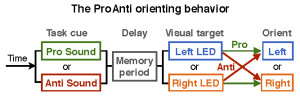 The ProAnti orienting behavior is inspired by the ProAnti saccade task. On Pro trials, subjects must respond toward a visual target for reward. On Anti trials, subjects orient away from a target for reward. We trained rats to flexibly and rapidly switch between these two sensorimotor associations. This challenging cognitive control behavior has, until now, been studied exclusively in human and non-human primates.
The ProAnti orienting behavior is inspired by the ProAnti saccade task. On Pro trials, subjects must respond toward a visual target for reward. On Anti trials, subjects orient away from a target for reward. We trained rats to flexibly and rapidly switch between these two sensorimotor associations. This challenging cognitive control behavior has, until now, been studied exclusively in human and non-human primates.
The code at the link below will run under the Bcontrol training system. Using this code will automatically train a rat to perform the “ProAnti task-switching” behavior.
Automated ProAnti Task-Switching Training Code
After downloading, unzip the file, and you will find two directories and two files.
- The directory “@Classical” contains the code for a protocol that we use to initialize rat training; with this protocol they learn to associate LEDs in the left and right nose ports with water rewards.
- The directory “@ProAnti” contains the code for training rats in the ProAnti task-switching behavior. Rats first train for ~7 days on @Classical; and are then moved to @ProAnti.
- The file “settings_@Classical_Ann_A167_140502a.mat” contains the settings to initialize training on @Classical for a naive rat. Note that they’re set for a rat called “A167” running under experimenter “Ann”, starting on May 02, 2014– you should of course change that to suit your own needs.
- The file “settings_@SameDifferent_Ann_A140_150124a” contains the settings to initialize training on @ProAnti for a rat that has already been trained on @Classical. As above, change the name and date to suit your needs.
To train a rat, set it on the @Classical protocol with the @Classical settings provided (~ 7 days). The settings will automatically update as they need from one day to the next. After that, start the rat on the @ProAnti protocol with the given settings. Wait ~3 months. Depending on your experimental needs, you can then choose to move your rat onto the stage of fully interleaved ProAnti switching paradigm (stage 11) or random-block-length paradigm (stage 10).
Remember: although training will run in an automated manner, it is always good to monitor your rats! Individuals sometimes need adjustments.
